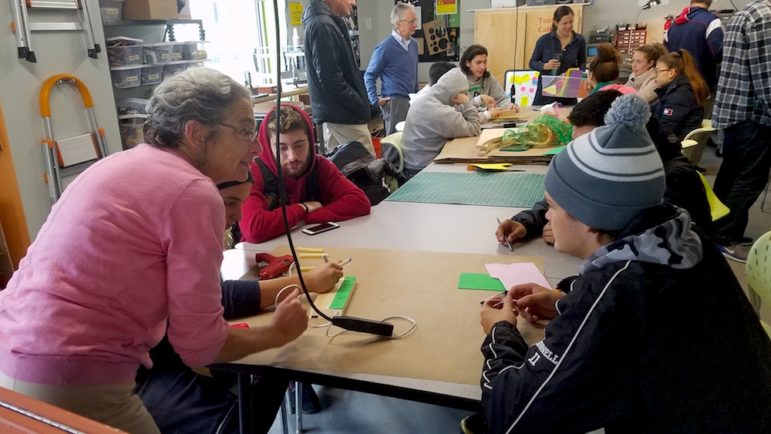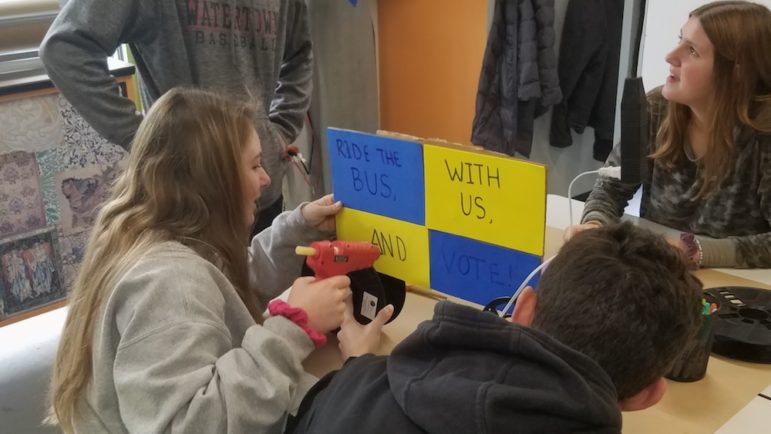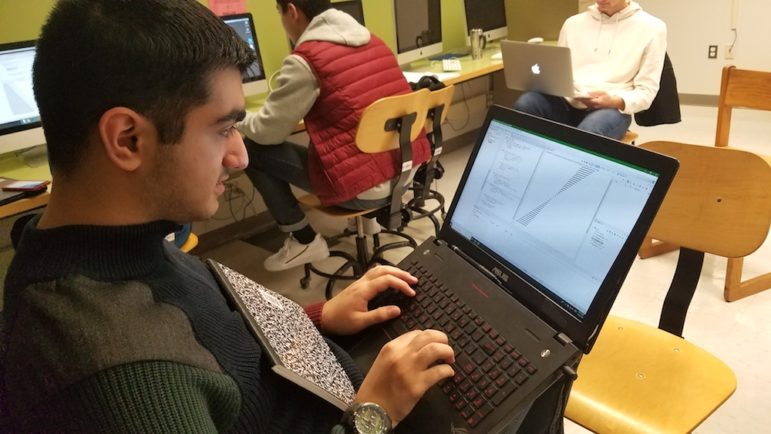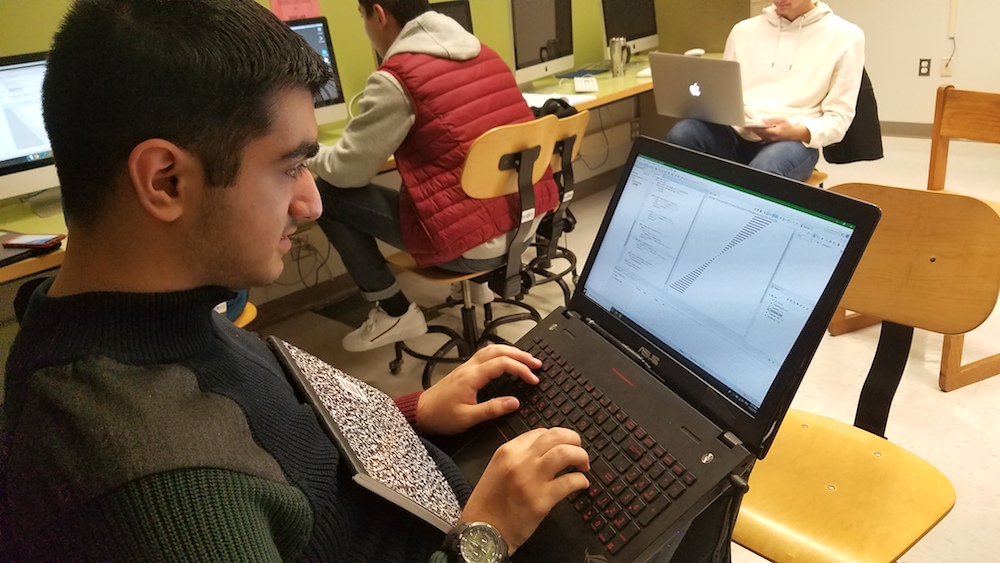
Charlie Breitrose
Watertown High School Digital Learning Coach Beth Lloyd helps student brainstorm ideas to get youth interested in voting. The civics class took a field trip to the Hatch maker space.
In an effort to boost interest by students in STEM education — science, technology, engineering and math — the Baker-Polito Administration declared Oct. 22-26, 2018 STEM Week. The Watertown Public Schools organized a range of events for students in elementary, middle and high school, including field trips to local companies, panels of professionals, and design challenges.
Some of the students and classes attending the events are from STEM subjects, but there are others from classes like civics and economics.
Laura Alderson Rotondo, the district’s Career Technical Education (CTE) coordinator, said she would have liked to have gotten every student in the district involved in the STEM Week activities, but having started planning in September it was not possible.
“I would like to get to the point, like The Hour of Code, where everyone gets at least something,” Rotondo said.
Rotondo worked with Beth Lloyd, the digital learning coach at Watertown High School, to organize activities for STEM week. It started with having students work on design challenges, Lloyd said, where they take on a problem and design, build, and test a prototype solution. However, WHS Principal Shirley Lundberg came up with ideas to broaden the activities.
Design Challenges
The design challenges will be a big part of STEM Week in Watertown. WHS students will head to Watertown Middle School, where all the seventh graders will participate in design challenges. Also, middle school students will be going to the three elementary schools to work with fifth graders on a design challenge of their own.
Another group that took on a design challenges was John Rimas’ civics class that headed to the Watertown Library’s Hatch maker space, located on Summer Street. Their task was to design something to get youth interested in voting in the upcoming election.
There to assist them was Liz Helfer, the Hatch coordinator, and they also had a visit from Watertown State Rep. Jonathan Hecht.
A few WHS students will be old enough to vote in the Nov. 6 Massachusetts election, Rimas said, but the school has another exercise to get them into the political process.
“We are doing the National Mock Election — we do the governor, the senate race and the ballot questions,” Rimas said.

Charlie Breitrose
Watertown High School students create a prototype to demonstrate how they would get teens excited about voting.
The students only had about 40 minutes to come up with an idea, make a prototype and then present it to their classmates. The students broke into four groups and brainstormed ways they could encourage other teens to go vote. They grabbed their scissors and glue guns to create models representing their ideas.
One group came up with a slogan to put on ads on MBTA buses, “Ride the bus, with us, and Vote!” said WHS senior Chris Iannetta. Lloyd said she thought it worked well because many young people don’t have cars, and Rimas said he thinks advertising on buses can be more powerful than social media.
A second group proposed giving a free cup of coffee to people who vote. The mock Dunkin’ Donuts cup had the slogan “America Runs on Your Vote,” and had a place for the person to check off their person’s party, said senior Renata DaSilva.
Senior Max Brunnell said his group proposed giving free Uber rides to the polls. Someone noted that Uber is going to do that for the election. Brunnell added that, “When they get their, they get a free hug. or if they don’t like that they get a firm handshake.” People also get free candy after they vote.
The final group decided to have a school assembly, to “inform our peers about the history of voting, how groups got the right to vote and why it is important to exercise their vote,” said senior Abbi Peterson. Senior Emma McGoldrick said they wanted to limit the assembly to 30 minutes, “so they don’t get bored.”
Professional Panels
WHS students can choose to go to one of the three panels of professionals, which includes engineers, professors, entrepreneurs and others. Some of the companies and schools represented are Watertown companies Markforged and Seven Cycles, as well as Turo, Iron Mountain and Tufts University.
“The thing I am most excited about are the professional panels,” Rotondo said. “We have 12 professionals coming in, and the first panel will be moderated by WBUR personality Bruce Gellerman.”

Charlie Breitrose
Civics students put the finishing touches on the MBTA bus ad prototype they proposed to get high schoolers interested in voting.
The panels are designed to show students how they get from where they are now, in high school, to become professionals in different fields, Lloyd said.
“They will show them how to get where they are. There is no path to becoming a maker space coordinator,.” Lloyd said referring to Hatch maker space coordinator Liz Helfer. “Her background is as a welder and artist.”
Field Trips
Lloyd reached out to local companies to see if they would be willing to participate in the professional panels, or even host groups of WHS students for a tour.
“We wanted to connect to the community to get businesses connected with us,” Lloyd said. “They understand students are the pipeline to business.”
A group of students from the introduction to robotics class visited iRobot, while an economics class stopped by Pulpdent, in Watertown. The company creates dental instruments and products used worldwide, and Lloyd said the students will get to see the steps that the company takes to create their products, in particular a disposal dental mirror.
“They will get to see the research and development of products, the manufacturing, packaging and shipping,” Lloyd said.
Despite being a family-owned company, they compete with big companies.
“They are competing with 3M. They have to be flexible,” Lloyd said.
STEM at WHS
While STEM Week seeks to expand teaching in science and technology subjects, Watertown already has some advanced courses in those subjects. Rotondo teaches engineering courses, there is a robotics class, and WHS has a AP Computer Science Applications.
“We are a small high school with a lot of electives, which is really awesome,” Rotondo said, added that the school is trying to identify students who would be interested in engineering and design, perhaps as early as middle school. “We are talking about targeting a cohort of students to make sure they are taking the right science and math classes to prepare for the engineering courses.”
On Monday, State Sen. Will Brownsberger came to observe the AP Computer Science course where students used their knowledge of the Java computer programing language to make an art project.
Teacher Toni Carlson told the students that by changing the numbers in the code, and the characters that are displayed, they can come up with new ideas.

Charlie Breitrose
Watertown High School senior Sepehr Madani wrote the code to create the design on his screen as part of an assignment in the AP Computer Science Applications class.
Senior Sepehr Madani came up with two halves of a circle that come together to make an hourglass shape. He said he hopes to find a way to make a complete circle.
“This is my favorite class,” Madani said. “I want to make this my career, computer programing.”
By the end of the year, the students will be writing programs that display all the cards in a deck, and will be able to make different cards come up.
Carlson’s background is not in computers. In fact she was an English major who went into library science. She is teaching herself computer programming, and Carlson also gets help from volunteers from the TEALS program, which matches people in the tech industry with schools to help them teach programming. On Monday, Jacob Lisi was the volunteer. He works at a local company as a programer, and said he did not have classes like this at his high school in Rhode Island.
“I am glad it is more popular,” Lisi said. “When you get to college and kids have been doing it for four years, there is definitely a disparity. It would definitely be ideal if it was embedded int he curriculum.”
Carlson said she hopes that students will be able to use what they learn in her class in the future.
“There are a lot of empty jobs — good jobs and good paying — that can’t be filled because there aren’t enough programmers,” Carlson said.
